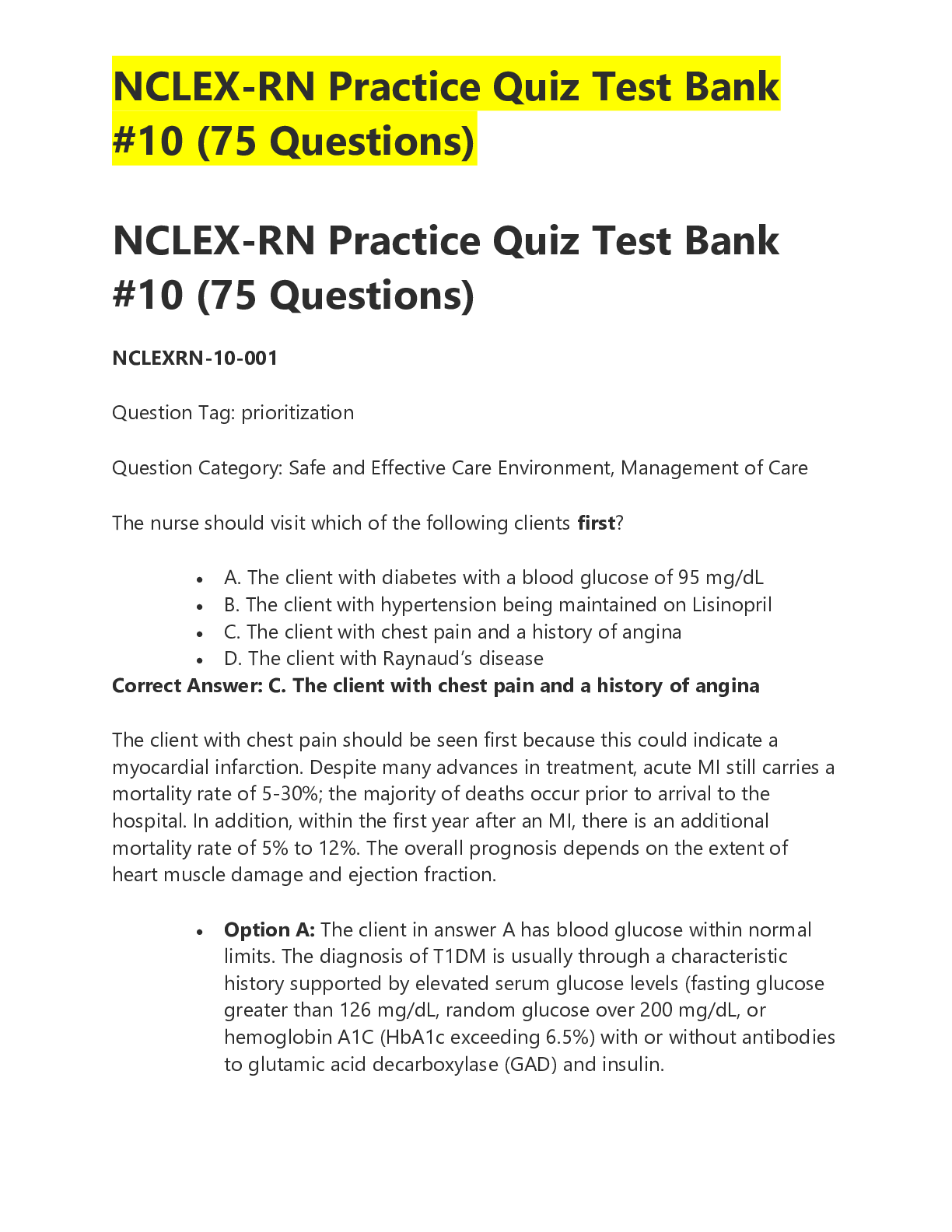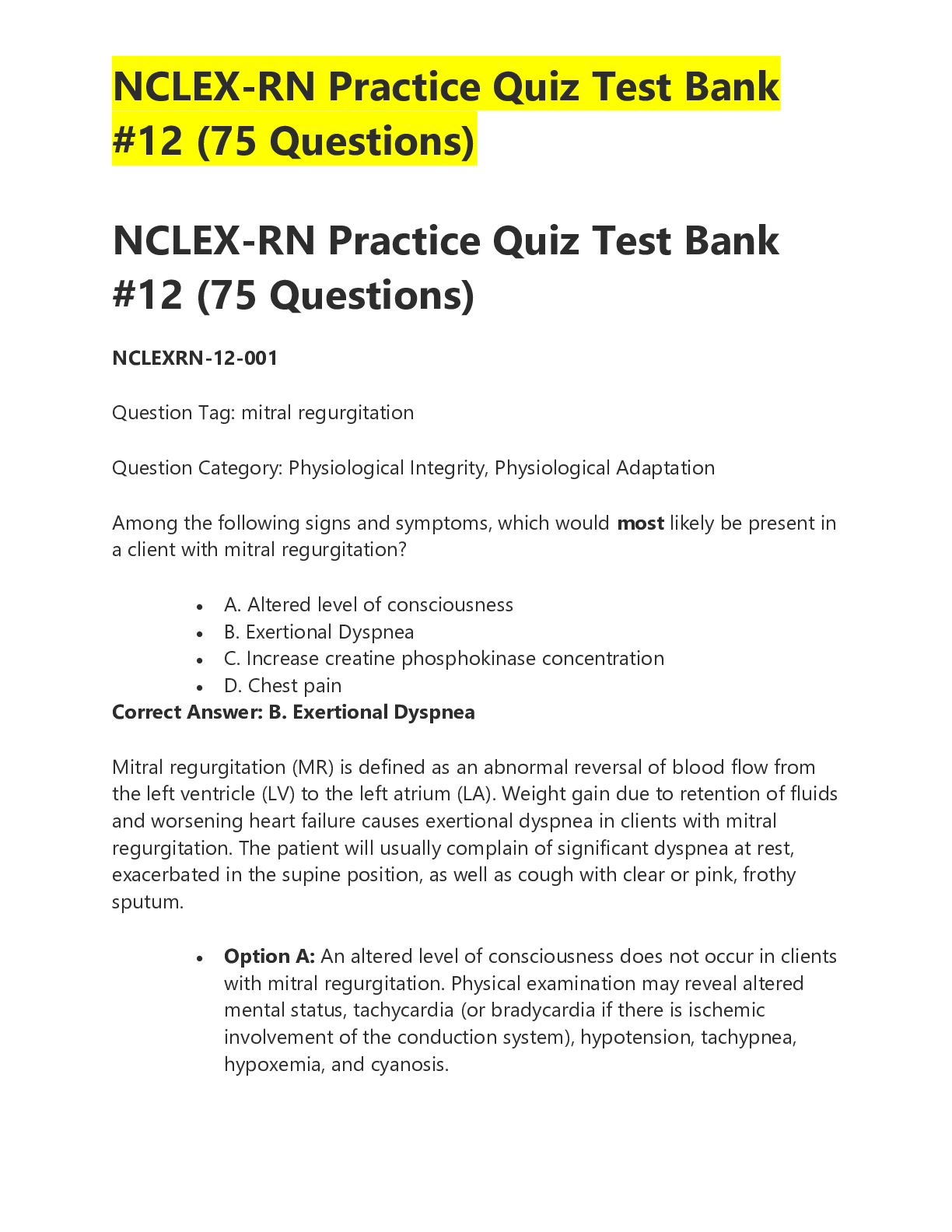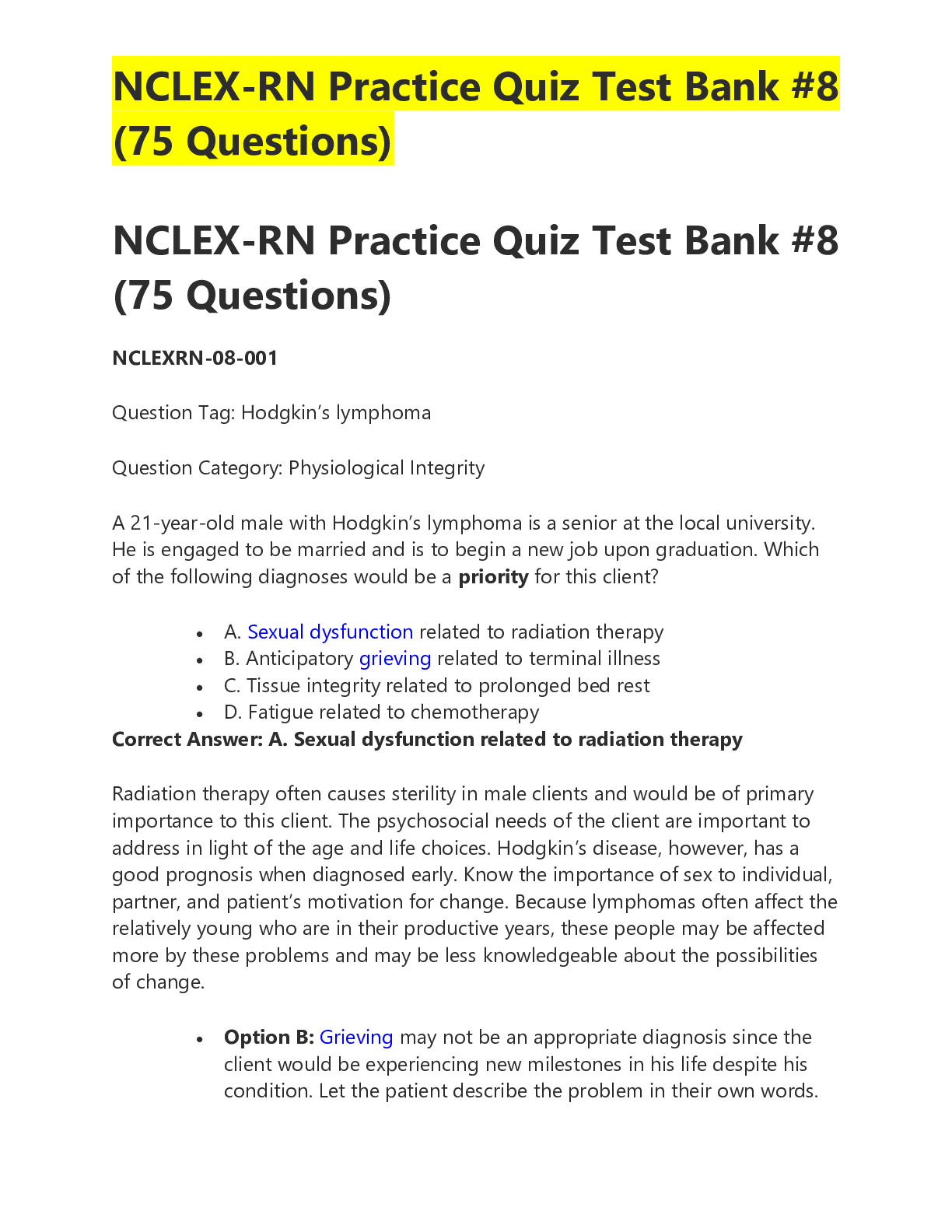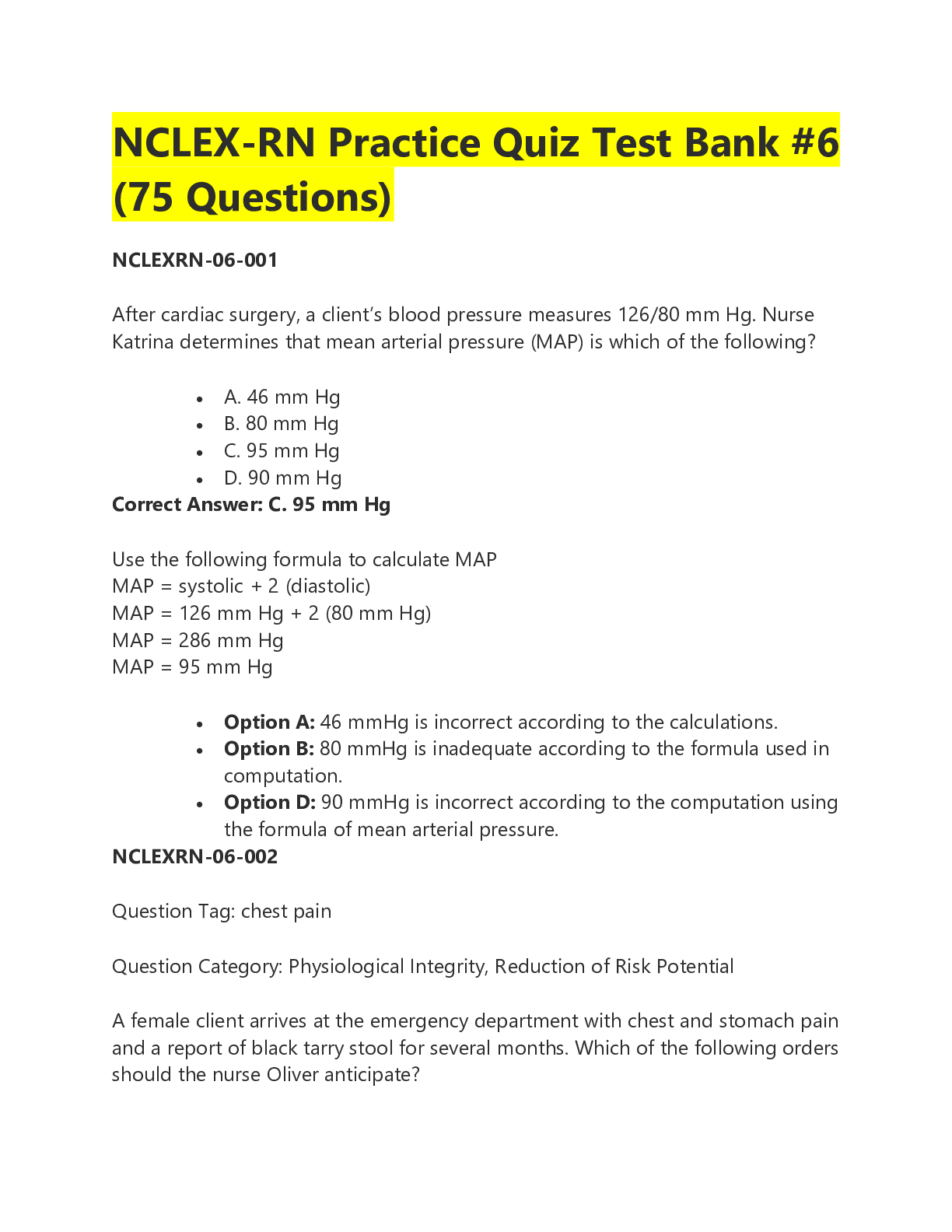*NURSING > NCLEX-RN > FULL-TEXT: NCLEX-RN Practice Quiz Test Bank (900 Questions with answers provided with explanations) (All)
FULL-TEXT: NCLEX-RN Practice Quiz Test Bank (900 Questions with answers provided with explanations) UPDATED ON OCTOBER 26, 2021 BSN, R.N.
Document Content and Description Below
NCLEX-RN Practice Quiz Test Bank #1 (75 Questions) NCLEXRN-01-001 Question Tag: hypertension Question Category: Physiological Integrity, Reduction of Risk Potential Which individual is at greatest... risk for developing hypertension? A. 45-year-old African-American attorney B. 60-year-old Asian-American shop owner C. 40-year-old Caucasian nurse D. 55-year-old Hispanic teacher Correct Answer: A: 45-year-old African American attorney Option A: African-Americans develop high blood pressure at younger ages than other groups in the US. Researchers have uncovered that African-Americans respond differently to hypertensive drugs than other groups of people. They are also found out to be more sensitive to salt, which increases the risk of developing hypertension. Option B: The incidence of hypertension in Asian-Americans does not appear to be significantly higher than the general population, according to limited US data. Option C: The racial disparity in hypertension and hypertension-related outcomes has been recognized for decades with African-Americans with greater risks than Caucasians. Option D: Hypertension prevalence rates in Hispanics may vary by gender and country of origin. Hispanic Americans overall have relatively low levels of hypertension, despite elevated levels of diabetes and obesity. NCLEXRN-01-002 Question Tag: acetaminophen Question Category: Physiological Integrity, Pharmacological and Parenteral Therapies A 15-year-old female who ingested 15 tablets of maximum strength acetaminophen 45 minutes ago is rushed to the emergency department. Which of these orders should the nurse do first? A. Gastric lavage B. Administer acetylcysteine (Mucomyst) orally C. Start an IV Dextrose 5% with 0.33% normal saline to keep the vein open D. Have the patient drink activated charcoal mixed with water Correct Answer: A. Gastric lavage Option A: Acetaminophen overdose is extremely toxic to the liver causing hepatotoxicity. Early symptoms of hepatic damage include nausea, vomiting, abdominal pain, and diarrhea. If not treated immediately, hepatic necrosis occurs and may lead to death. Removing as much of the drug as possible is the first step in treatment for acetaminophen overdose, this is best done through gastric lavage. Gastric lavage (irrigation) and aspiration consist of flushing the stomach with fluids and then aspirating the fluid back out. This procedure is done in life-threatening cases such as acetaminophen toxicity and only if less than one (1) hour has occurred after ingestion. Option B: The oral formulation of acetylcysteine is the drug of choice for the treatment of acetaminophen overdose but should be done after GI decontamination with activated charcoal. Liver damage is minimized by giving acetylcysteine (Mucomyst), the antidote for acetaminophen. Acetylcysteine reduces injury by substituting for depleted glutathione in the reaction that converts the toxic metabolite of acetaminophen to its nontoxic form. When given within 8 hours of acetaminophen toxicity, acetylcysteine is effective in preventing severe liver injury. It is administered orally or intravenously. Option C: Intermittent IV infusion with Dextrose 5% may be considered for latepresenting or chronic ingestion. Option D: Oral activated charcoal (AC) avidly adsorbs acetaminophen and may be administered if the patient presents within 1 hour after ingesting a potentially toxic dose. Charcoal should not be administered immediately before or with antidotes since it can effectively adsorb it and neutralize the benefits. NCLEXRN-01-003 Question Tag: cardiac catheterization Question Category: Safe and Effective Care Environment, Management of Care Which complication of cardiac catheterization should the nurse monitor for in the initial 24 hours after the procedure? A. Angina at rest B. Thrombus formation C. Dizziness D. Falling blood pressure Correct Answer: B. Thrombus formation A thrombus formation may prevent blood from flowing normally through the circulatory system, which may become an embolism, and block the flow of blood towards major organs in the body. Option A: The reported incidence of myocardial infarction with angina at rest is less than 0.1%, and is mostly influenced by patient-related factors like the extent and severity of underlying cardiovascular-related diseases and technique-related factors. Options C & D: A falling BP and dizziness occur along with hemorrhage of the insertion site which is associated with the first 12 hours after the procedure. NCLEXRN-01-004 Question Tag: renal calculi, flank pain Question Category: Physiological Integrity, Basic Care and Comfort A client is admitted to the emergency room with renal calculi and is complaining of moderate to severe flank pain and nausea. The client’s temperature is 100.8 degrees Fahrenheit. The priority nursing goal for this client is: A. Maintain fluid and electrolyte balance B. Control nausea C. Manage pain D. Prevent urinary tract infection Correct Answer: C. Manage pain Managing pain is always a priority because it ultimately improves the quality of life. The cornerstone of ureteral colic management is analgesia, which can be achieved most expediently with parenteral narcotics or nonsteroidal anti-inflammatory drugs (NSAIDs). Option A: IV hydration in the setting of acute renal colic is controversial. Whereas some authorities believe that IV fluids hasten the passage of the stone through the urogenital system, others express concern that additional hydrostatic pressure exacerbates the pain of renal colic. Option B: Because nausea and vomiting frequently accompany acute renal colic, antiemetics often play a role in renal colic therapy. Several antiemetics have a sedating effect that is often helpful. Option D: Overuse of the more effective antibiotic agents leaves only highly resistant bacteria, but failure to adequately treat a UTI complicated by an obstructing calculus can result in potentially life-threatening urosepsis and pyonephrosis. Questions and rationale from Nurseslabs.com Feel free to print or share and link back to us! For more practice questions, please visit our Nursing Test Bank [https://nurseslabs.com/nursingtest-bank] NCLEXRN-01-005 Question Tag: growth, school age Question Category: Health Promotion and Maintenance What would the nurse expect to see while assessing the growth of children during their school age years? A. Decreasing amounts of body fat and muscle mass B. Little change in body appearance from year to year C. Progressive height increase of 4 inches each year D. Yearly weight gain of about 5.5 pounds per year Correct Answer: D. Yearly weight gain of about 5.5 pounds per year School age children gain about 5.5 pounds each year and increase about 2 inches in height. Between ages 2 to 10 years, a child will grow at a steady pace. Option A: Decreasing amounts of body fat and muscle mass are common in toddlers. Option B: A decrease in the change in body appearance occurs among young adults. Option C: Growth spurts are common in school-age children, as are periods of slow growth. NCLEXRN-01-006 Question Tag: blood pressure Question Category: Health Promotion and Maintenance At a community health fair, the blood pressure of a 62-year-old client is 160/96 mmHg. The client states “My blood pressure is usually much lower.” The nurse should tell the client to: A. Go get a blood pressure check within the next 15 minutes B. Check blood pressure again in two (2) months C. See the healthcare provider immediately D. Visit the health care provider within one (1) week for a BP check Correct Answer: A. Go get a blood pressure check within the next 15 minutes. The blood pressure reading is moderately high with the need to have it rechecked after a few minutes to verify. The client states it is ‘usually much lower.’ Thus a concern exists for complications such as stroke. Options B & D: Waiting 2 months or a week for follow-up is too long. Option C: Immediate check by the provider of care is not warranted. NCLEXRN-01-007 Question Tag: prioritization Question Category: Safe and Effective Care Environment, Safety and Infection Control The hospital has sounded the call for a disaster drill on the evening shift. Which of these clients would the nurse put first on the list to be discharged in order to make a room available for a new admission? A. A middle-aged client with a history of being ventilator dependent for over seven (7) years and admitted with bacterial pneumonia five days ago. B. A young adult with diabetes mellitus Type 2 for over ten (10) years and admitted with antibiotic-induced diarrhea 24 hours ago. C. An elderly client with a history of hypertension, hypercholesterolemia, and lupus, and was admitted with Stevens-Johnson syndrome that morning. D. An adolescent with a positive HIV test and admitted for acute cellulitis of the lower leg 48 hours ago. Correct Answer: A. A middle-aged client with a history of being ventilator dependent for over seven (7) years and admitted with bacterial pneumonia five days ago. The best candidate for discharge is one who has had a chronic condition and is most familiar with their care. This client in option A is most likely stable and could continue medication therapy at home. Option B: The client with antibiotic-induced diarrhea still needs continuous strict monitoring as the blood sugar levels may become unstable and dehydration is still possible. Option C: Stevens-Johnson syndrome (SJS) is a rare, serious disorder of the skin and mucous membranes. It’s usually a reaction to medication that starts with flu-like symptoms, followed by a painful rash that spreads and blisters. Option D: Cellulitis is often an underestimated complication of HIV disease, but they are responsible for an appreciable morbidity. NCLEXRN-01-008 Question Tag: hypothyroidism, levothyroxine Question Category: Physiological Integrity, Pharmacological and Parenteral Therapies A 25-year-old male client has been newly diagnosed with hypothyroidism and will take levothyroxine (Synthroid) 50 mcg/day by mouth. As part of the teaching plan, the nurse emphasizes that this medication: A. Should be taken in the morning B. May decrease the client’s energy level C. Must be stored in a dark container D. Will decrease the client’s heart rate Correct Answer: A. Should be taken in the morning Option A: Levothyroxine (Synthroid) has a side effect of insomnia. Taking it in the morning could prevent interfering with the client’s sleeping pattern. Option B: Some of the side effects of Levothyroxine include hyperactivity and increase in heart rate. Option C: Keep this drug in a cool, dark, and dry place. Option D: A decrease in the heart rate is a desired effect of Levothyroxine. NCLEXRN-01-009 Question Tag: epiglottis Question Category: Physiological Integrity, Physiological Adaptation A 3-year-old child was brought to the pediatric clinic after the sudden onset of findings that include irritability, thick muffled voice, croaking on inspiration, hot to touch, sit leaning forward, tongue protruding, drooling and suprasternal retractions. What should the nurse do first? A. Prepare the child for X-ray of upper airways B. Examine the child’s throat C. Collect a sputum specimen D. Notify the healthcare provider of the child’s status Correct Answer: D. Notify the healthcare provider of the child’s status These findings suggest a medical emergency and may be due to epiglottitis. Any child with an acute onset of an inflammatory response in the mouth and throat should receive immediate care. Option A: If epiglottitis is seriously considered, no imaging studies are required. In lessclear cases, imaging studies are occasionally helpful in establishing the diagnosis or excluding epiglottitis. Option B: Examining the child’s throat should not be attempted because it may compromise respiratory effort. Option C: There are no indications for collection of sputum specimens. NCLEXRN-01-010 Question Tag: diabetes, school-age Question Category: Physiological Integrity, Physiological Adaptation In children suspected to have a diagnosis of diabetes, which one of the following complaints would be most likely to prompt parents to take their school-age child for evaluation? A. Polyphagia B. Dehydration C. Bedwetting D. Weight loss Correct Answer: C. BedwettingOne of the first symptoms of type 1 diabetes in children is bedwetting. Bedwetting in a schoolage child is readily detected by the parents. Option A: Polyphagia or extreme hunger is one of the most common symptoms of diabetes both among adults and children. Option B: Dehydration is not a symptom of type 1 diabetes, but it can be one of the many complications. Option D: Unintentional weight loss would develop gradually in a child with type 1 diabetes. NCLEXRN-01-011 Question Tag: pelvic inflammatory disease Question Category: Physiological Integrity, Physiological Adaptation A client comes to the clinic for treatment of recurrent pelvic inflammatory disease. The nurse recognizes that this condition most frequently follows which type of infection? A. Trichomoniasis B. Chlamydia C. Staphylococcus D. Streptococcus Correct Answer: B. Chlamydia Option B: Chlamydial infections are one of the most frequent causes of salpingitis or pelvic inflammatory disease. Chlamydial bacteria could travel up toward the vagina or cervix into the reproductive organs. Option A: Trichomoniasis is a very common sexually transmitted disease, but it rarely predisposes to pelvic inflammatory disease. Option C & D: Staphylococcus and streptococcus may cause PID but it rarely occurs. NCLEXRN-01-012 Question Tag: prioritization Question Category: Safe and Effective Care Environment, Management of Care A registered nurse who usually works in a spinal rehabilitation unit is floated to the emergency department. Which of these clients should the charge nurse assign to this RN? A. A middle-aged client who says “I took too many diet pills” and “my heart feels like it is racing out of my chest.” B. A young adult who says “I hear songs from heaven. I need money for beer. I quit drinking two (2) days ago for my family. Why are my arms and legs jerking?” C. An adolescent who has been on pain medications terminal cancer with an initial assessment finding pupils and a relaxed respiratory rate of 11, D. An elderly client who reports having taken a “large crack hit” 10 minutes prior to walking into the emergency room. Correct Answer: C. An adolescent who has been on pain medications terminal cancer with an initial assessment finding pupils and a relaxed respiratory rate of 10. Nurses who are floated to other units should be assigned to a client who has minimal anticipated immediate complications of their problem. This client exhibits opioid toxicity with the pinpoint pupils and has the least risk of complications to occur in the near future. Option A: The client in option A might be experiencing an overdose. Option B: Client in option B is having withdrawal syndrome. Option D: The client in this option may experience a decrease in sensorium later on due to head trauma. NCLEXRN-01-013 Question Tag: coronary artery disease, nutrition Question Category: Health Promotion and Maintenance When teaching a client with coronary artery disease about nutrition, the nurse should emphasize: A. Eating three (3) balanced meals a day B. Adding complex carbohydrates C. Avoiding very heavy meals D. Limiting sodium to 7 gms per day Correct Answer: C. Avoiding very heavy meals Eating large, heavy meals can pull blood away from the heart for digestion and is dangerous for the client with coronary artery disease. Too much plaque may accumulate in the arteries and block the delivery of blood and oxygen in major organs of the body. Option A: Eating a balanced diet should be a part of the management of a client with coronary artery disease. Option B: Complex carbohydrates decrease inflammation and help decrease the risk of plaque build up in the arteries. Option C: People with cardiovascular diseases should have a limit of less than 1.5 grams per day. NCLEXRN-01-014Question Tag: morphine, pain management Question Category: Physiological Integrity, Pharmacological and Parenteral Therapies Which of these findings indicate that a pump to deliver a basal rate of 10 ml per hour plus PRN for pain breakthrough for morphine drip is not working? A. The client complains of discomfort at the IV insertion site B. The client states “I just can’t get relief from my pain.” C. The level of drug is 100 ml at 8 AM and is 80 ml at noon D. The level of the drug is 100 ml at 8 AM and is 50 ml at noon Correct Answer: C. The level of the drug is 100 ml at 8 AM and is 80 ml at noon The minimal dose of 10 mL per hour which would be 40 mL given in a four (4) hour period. Only 60 mL should be left at noon. The pump is not functioning when more than expected medicine is left in the container. Option A: Discomfort at the IV insertion site may indicate inflammation or infection of the site. Option B: Morphine is a strong painkiller indicated for severe pain. Option D: The pump is working correctly if there is only 50 ml left at noon. NCLEXRN-01-015 Question Tag: health promotion, chiropractic treatment Question Category: Health Promotion and Maintenance The nurse is speaking at a community meeting about personal responsibility for health promotion. A participant asks about chiropractic treatment for illnesses. What should be the focus of the nurse’s response? A. Electrical energy fields B. Spinal column manipulation C. Mind-body balance D. Exercise of joints Correct Answer: B. Spinal column manipulation The theory underlying chiropractic is that interference with transmission of mental impulses between the brain and body organs produces diseases. Such interference is caused by misalignment of the vertebrae. Manipulation reduces the subluxation. Option A: Too much exposure to electrical energy can become a hazard to one’s health. Option C: Mind-body balance refers to yoga. Option D: Low-impact aerobic exercises are easier on the joints but are not part of chiropractic medicine. NCLEXRN-01-016 Question Tag: neurological assessment, CVA Question Category: Physiological Integrity, Physiological Adaptation The nurse is performing a neurological assessment on a client post right cerebrovascular accident. Which finding, if observed by the nurse, would warrant immediate attention? A. Decrease in level of consciousness B. Loss of bladder control C. Altered sensation to stimuli D. Emotional lability Correct Answer: A. Decrease in level of consciousness A further decrease in the level of consciousness may indicate increase in intracranial pressure leading to inadequate oxygenation of the brain. A decrease in LOC may also reveal presence of a transient ischemic attack which may warn of impending thrombotic CVA. Option B: The patient post stroke may have transient urinary incontinence due to inability to communicate needs, or impaired motor and postural control. Control of the urinary sphincter may also be lost or diminished. Option C: Altered sensation to stimuli is expected for a patient post CVA. This may include sensory impairment to touch, loss of proprioception, difficulty interpreting visual, tactile, and auditory stimuli. Option D: Depression and anxiety are common responses by a patient after a catastrophic event such as in a stroke. Emotional lability (or pseudobulbar affect), refers to the involuntary and uncontrollable bursts of emotion without an emotional trigger. NCLEXRN-01-017 Question Tag: cystic fibrosis Question Category: Physiological Integrity, Physiological Adaptation A child who has recently been diagnosed with cystic fibrosis is in a pediatric clinic where a nurse is performing an assessment. Which later finding of this disease would the nurse not expect to see at this time? A. Positive sweat test B. Bulky greasy stools C. Moist, productive cough D. Meconium ileus [Show More]
Last updated: 1 year ago
Preview 1 out of 674 pages
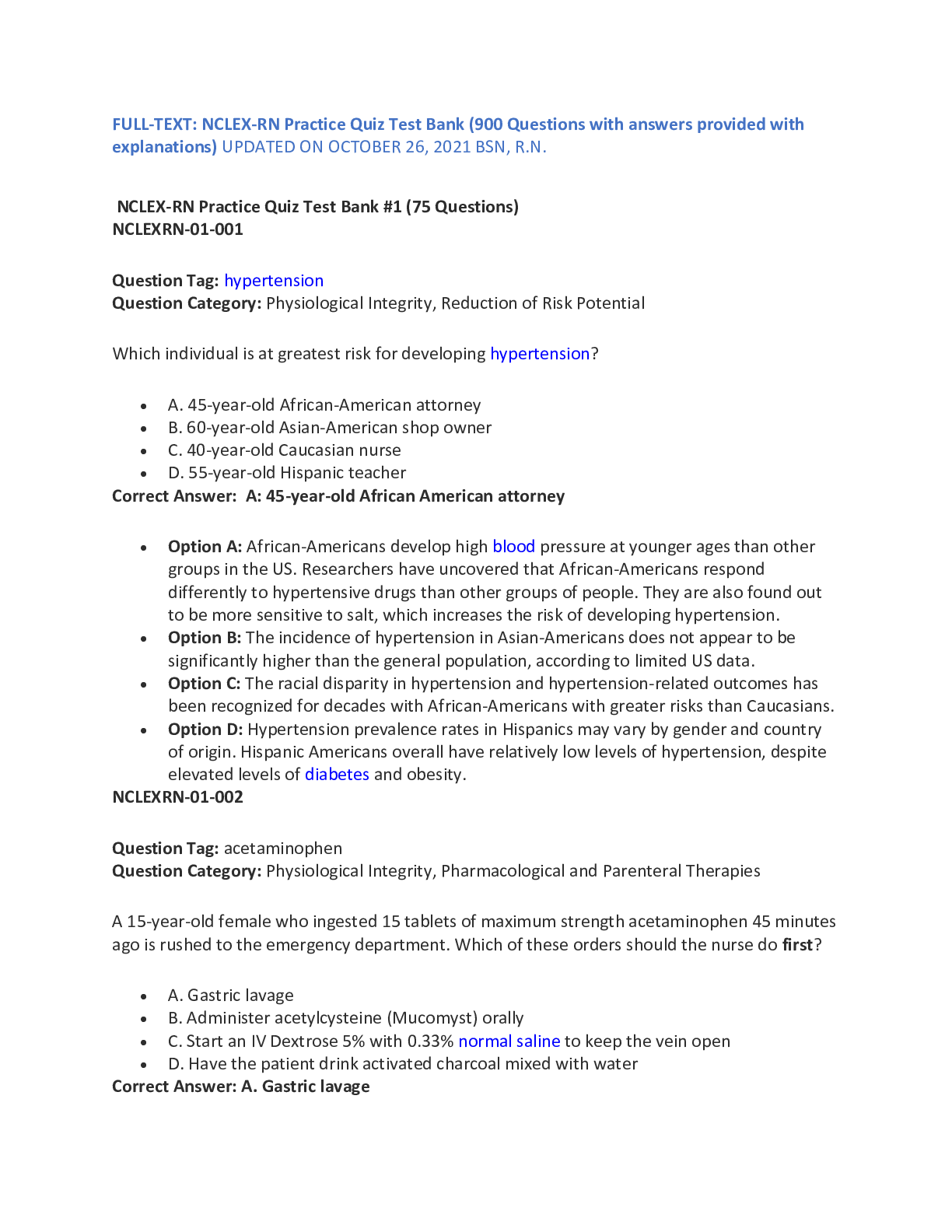
Reviews( 0 )
Document information
Connected school, study & course
About the document
Uploaded On
Jun 04, 2022
Number of pages
674
Written in
Additional information
This document has been written for:
Uploaded
Jun 04, 2022
Downloads
0
Views
138

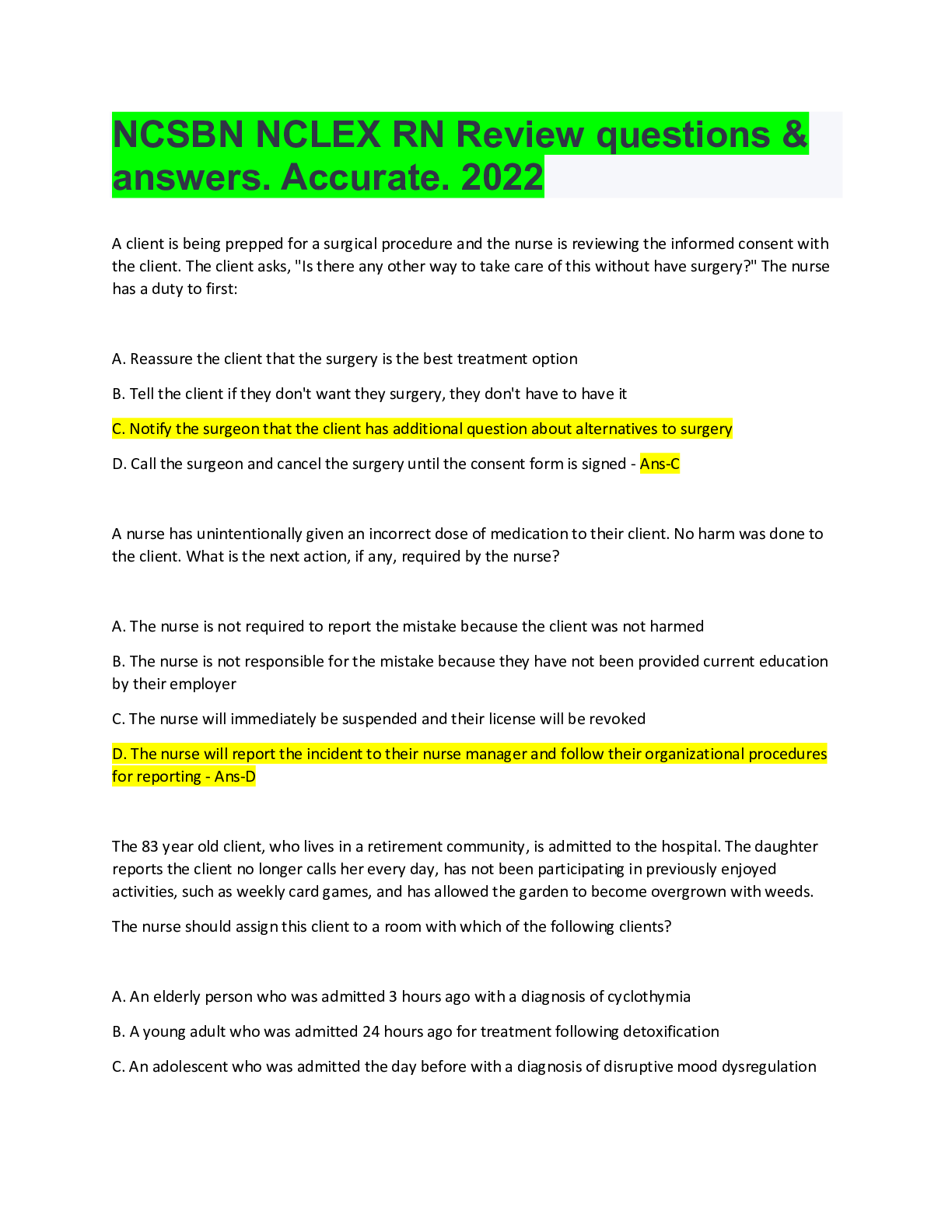
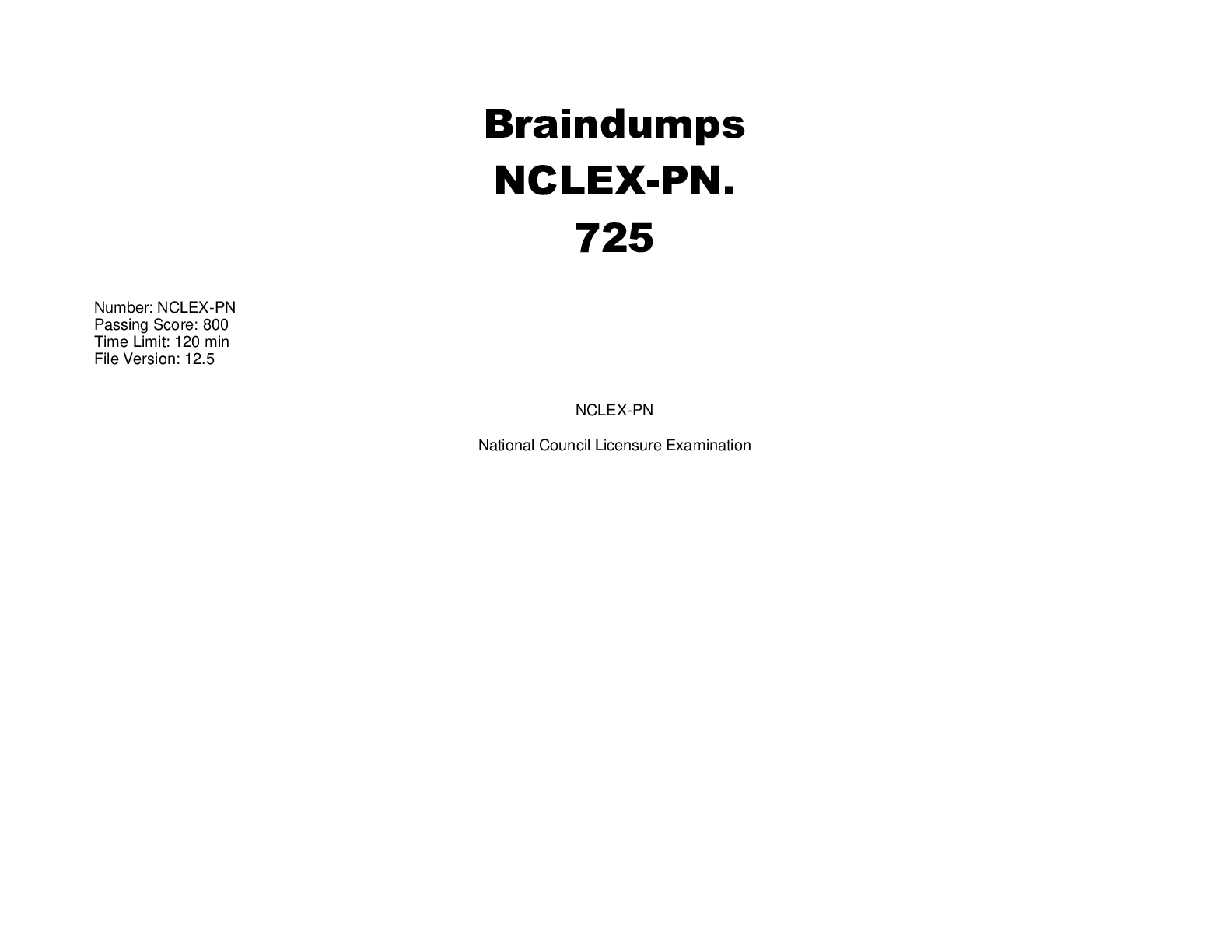
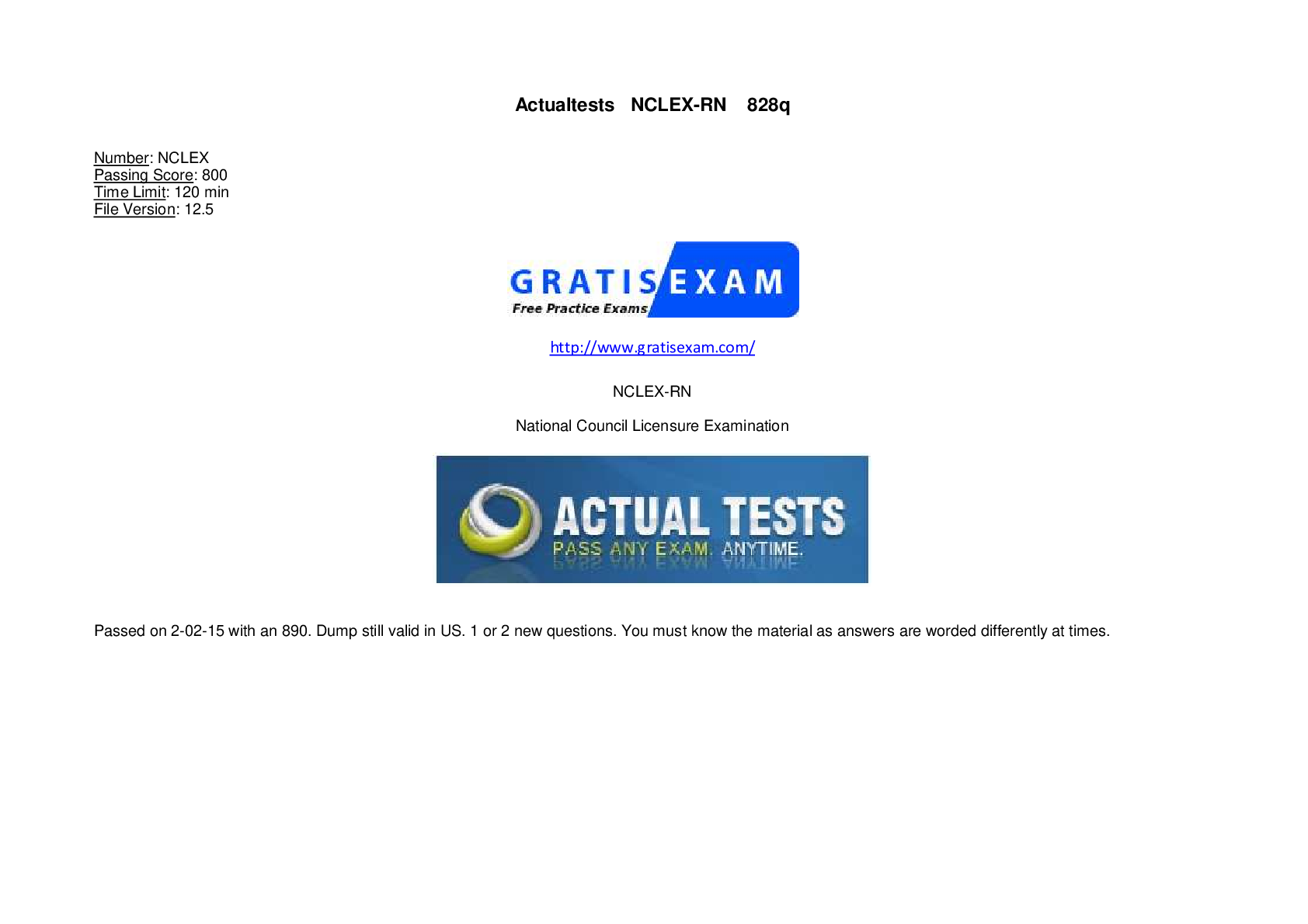
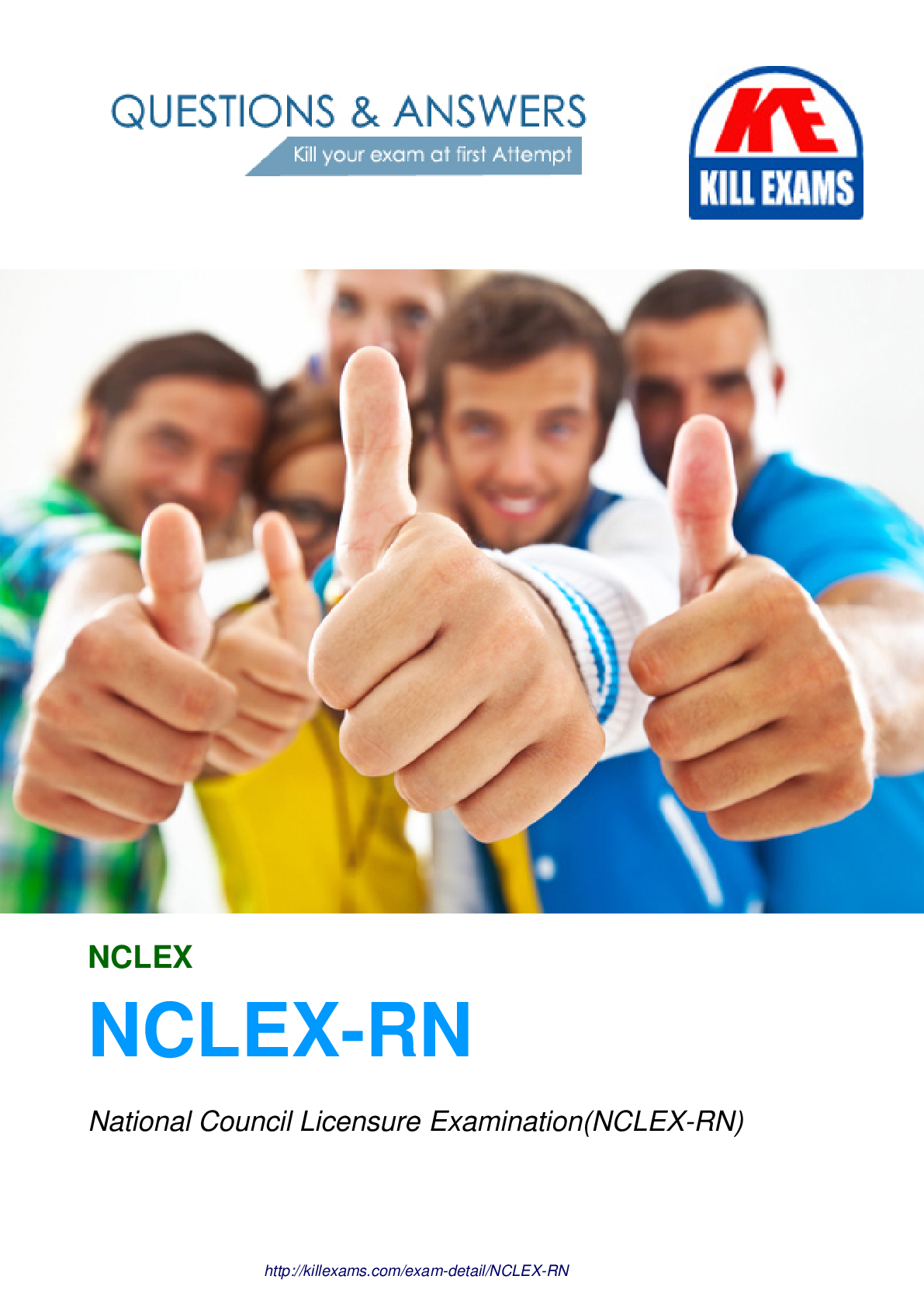


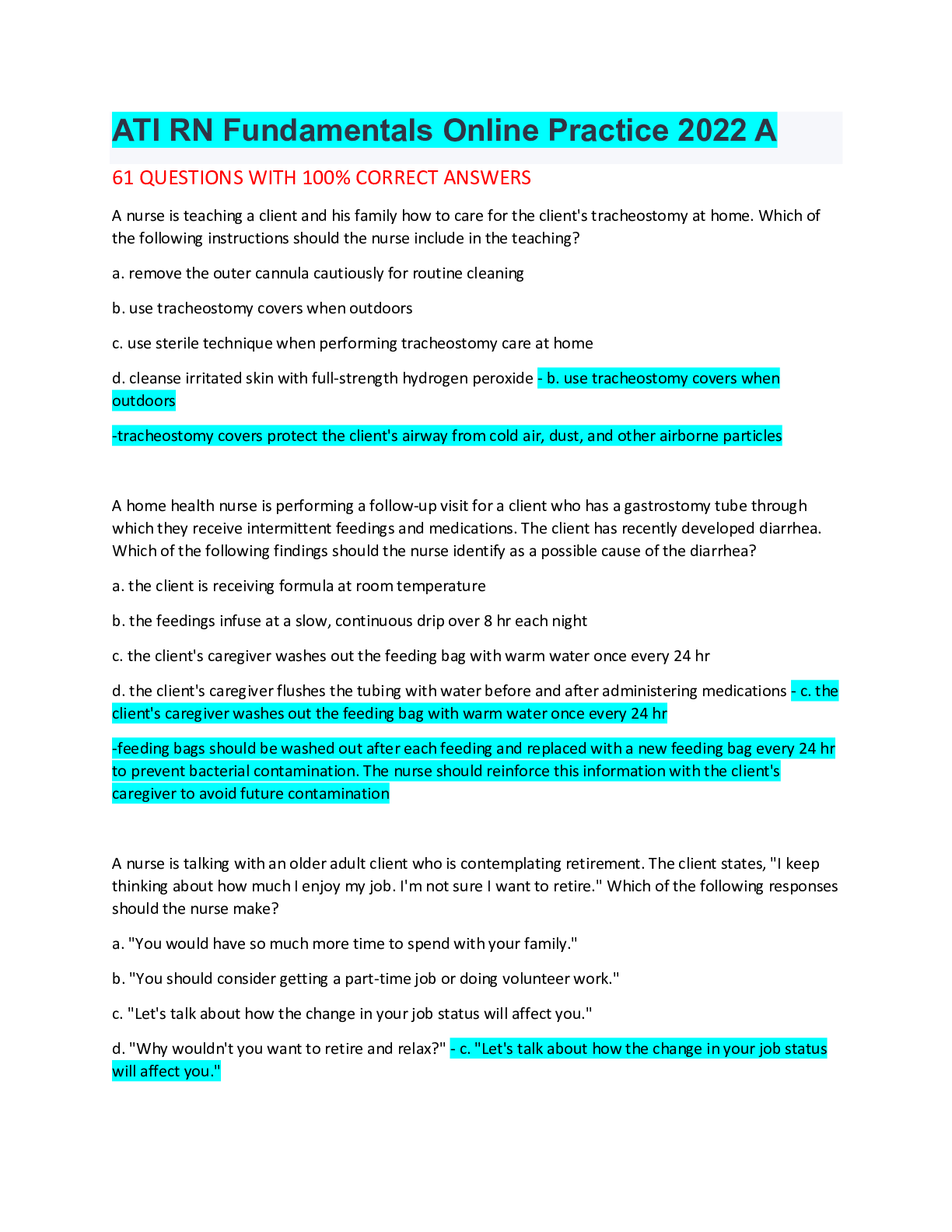
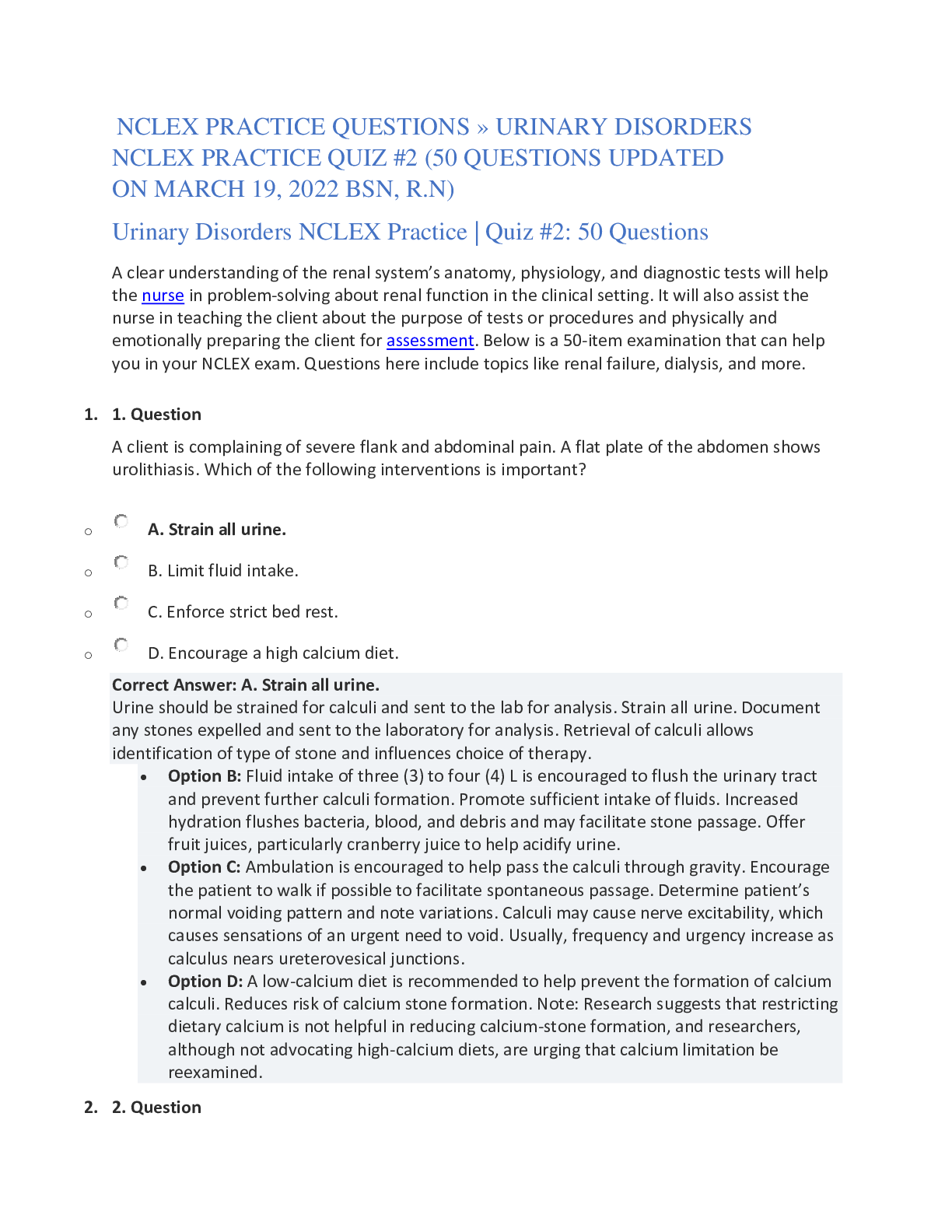

.png)
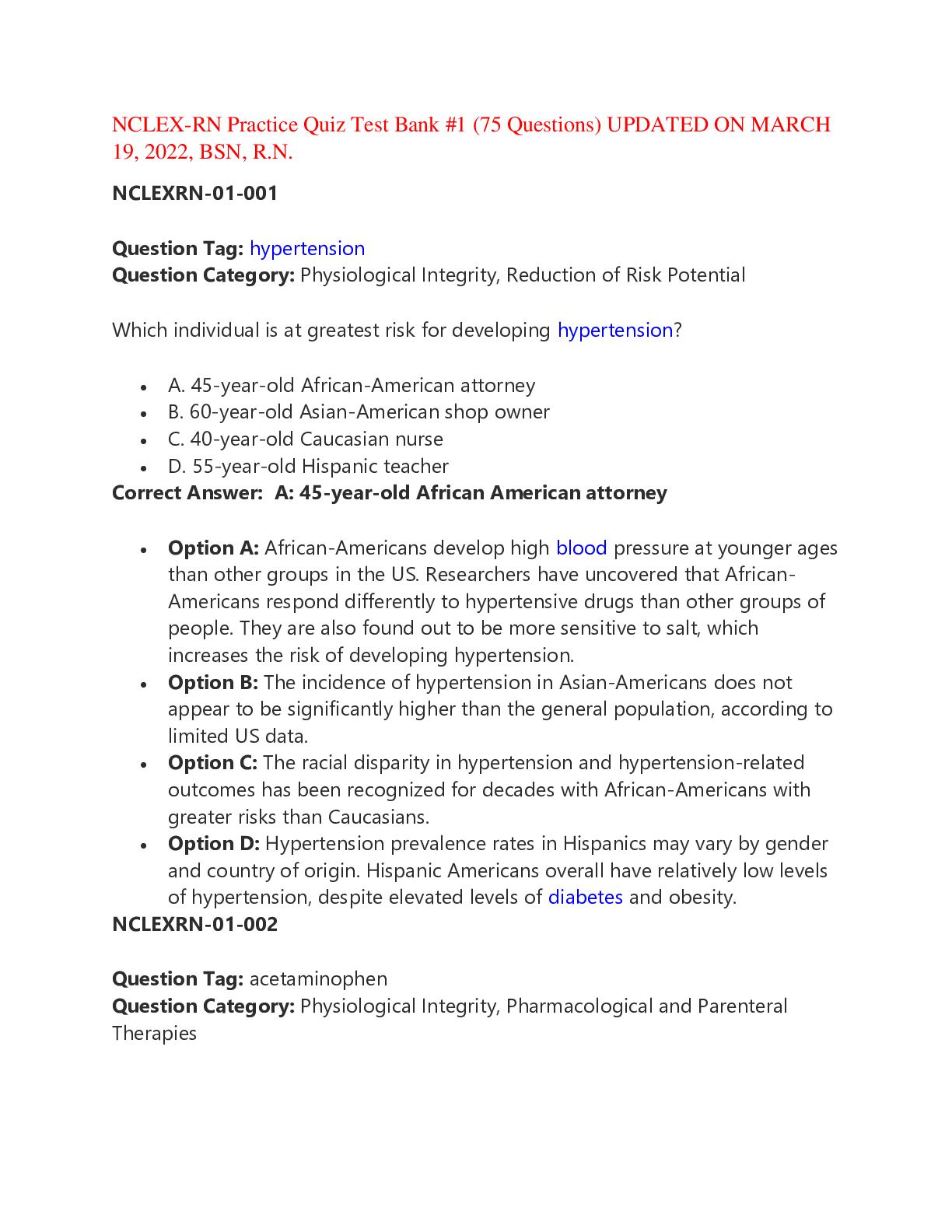
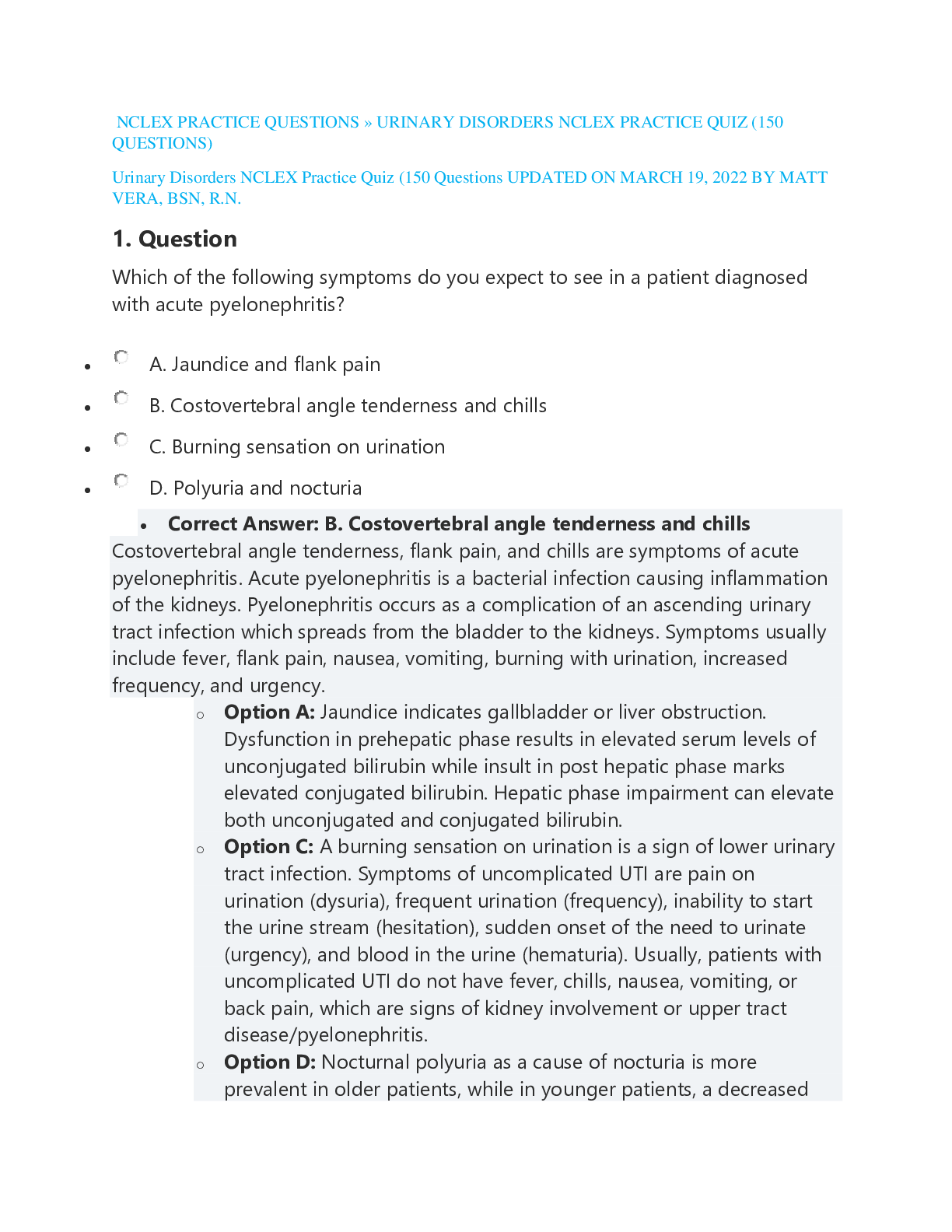
.png)
 UPDATED ON MARCH 19, 2022, BSN, R.png)
